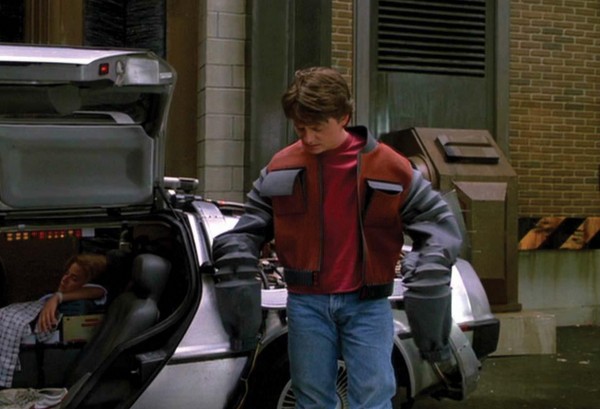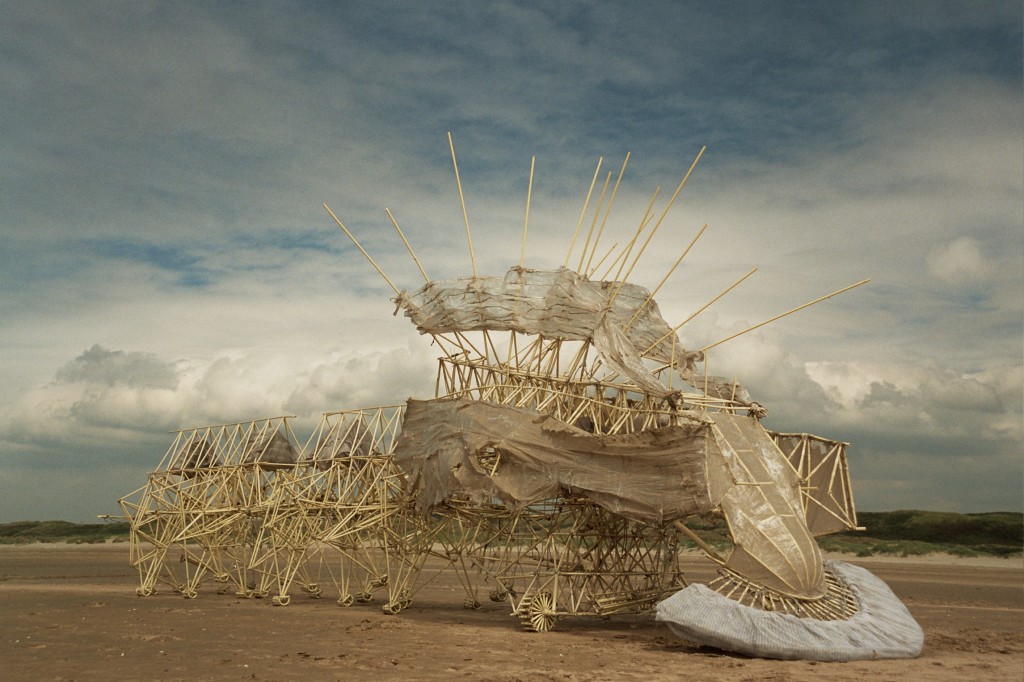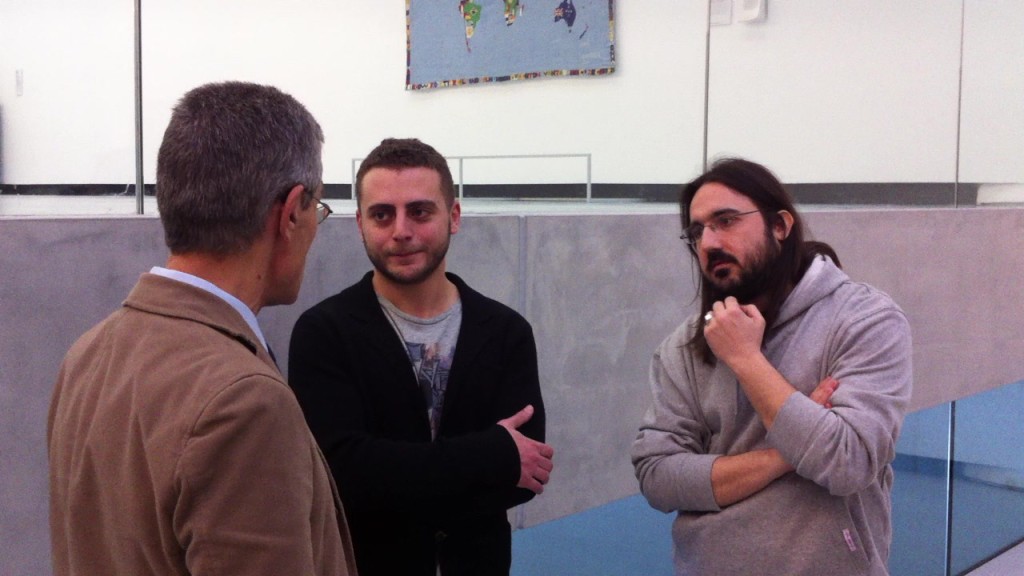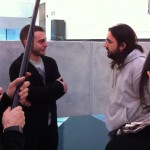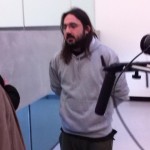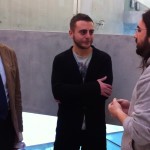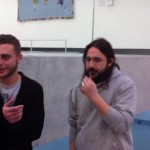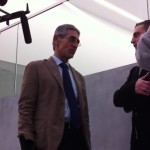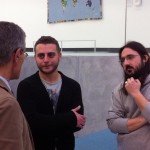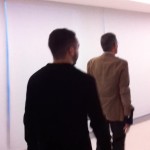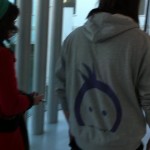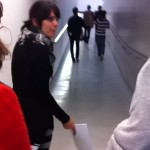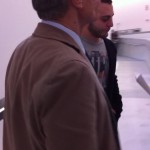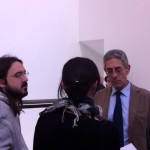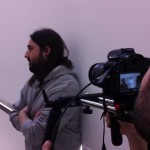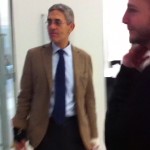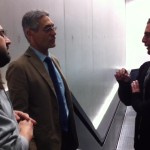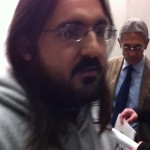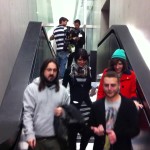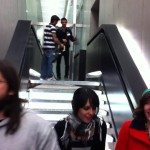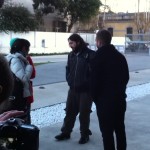PIO BALDI + PIOTTA – MY NAME IS PIO
an interview to PIO BALDI and PIOTTA. text by Francesco Lipari
Wednesday 15th December 2010 h 14:30 – We arrive on time for our appointment at the MAXXI with our two protagonists. It’s a sunny day, before coffee, we introduce ourselves and begin strolling through our capital’s new museum of art and architecture.
You may wonder why we chose two characters so seemingly distant, yet they have much in common: both are Romans, and both are engaged in promoting the culture of their city through a contemporary, yet critical viewpoint.
F.L.: The Grande Onda, founded in 2004 by Tommaso, wants to promote musical talent through the contribution of major music distributors. Tommaso can you tell us how this idea was born and what results you got?
T.Z.: The idea came from the fact that I had a lot of experience as an independent, both in terms of self-promotion and management of a disk, from the creative genesis to the physical realization of the media and everything else, so I wanted to provide this experience, both the service for my work that I did after as an independent for many new artists, maybe even younger and with less experience. They could count on getting the right advice and take their first steps in this field.
The results are twenty works produced by various Italian rappers.
Lately we don’t talk about rap only, for example in my latest album called “Suono diverso”, I mixed rap with rock. I needed a more aggressive tone to deal with all the political and social issues on the disc, and to show that this “Grande Onda” is also opening to other things.
If I have to name a few, I can tell you about Cor Veleno, the most important group on the Roman scene, and Amir, the first known rapper of the second generation. Amir is of Egyptian origin, living in Rome at Tor Pignattara, and is completely integrated in our social context. This is proof that there is a possible future peaceful and creative and mutual enrichment between people, civilizations, and different stories in a city like Rome.
F.L.: President, do you think, Maxxi can become the “Grande Onda” and an engine to promote young architects?
P.B.: Yes, both for young architects and young artists. Maxxi arises, not from the concept of museum, but as a concept of fluidity. When we think about the basis of a museum piece, we can think of something old, dusty, something to be scrapped.
The idea of a museum does not make a good idea of Maxxi.
Maxxi wants to be a point where we are entering and leaving the ideas. A factory of culture, a place where the arts such as architecture, music, dance, entertainment, advertising are mixed and producing new languages, as an antenna that receive informations and leaves them as creative messages.
F.L.: President, the Maxxi message is very clear, imploding within the culture of the past and then “unrolling”, as you said, the contemporary, the culture of tomorrow. What strategies does Maxxi have in order to maintain the public’s attention and above all, what is its idea of contemporary?
P.B.: About architecture we must have both exhibitions that talk about young talents, along with exhibitions made by historical figures such as Moretti, Morandi. Our intent is to be able to weave in the recent history, in which Italian architectoni culture had a very strong influence. Just think of the past 60-70 years, almost 80, and about a projection on the future based on the very young architects. There will be, for example, a competition for young architects in April and May with whom you want to build and bring to Maxxi a sensible space, which then will be used for various activities, such as music, theater, television, not only until the beginning of summer, but also in subsequent months.
F.L.: To promote the contemporary world, to be original or to create something special, do we need interdisciplinarity?
P.B.: Yes, as I said before we try to mix art and architecture with cultural activities that have estetic components as design, advertising, fashion and cinema, to build new ideas.
F.L.: Tommaso, what is your idea of modernity from both an architectural and music point of view?
T.Z.: From the perspective of hip hop music there is something similar to architecture. Hip hop takes something old and makes something new. It renews.
There’s always this coexistence between conservation and innovation.
Since its origins. Hip hop always looked to the past. We talk about the music of the guys in New York during the ‘70s, which in the present every country has accommodated according to their own tastes and needs.
The idea of Roman hip-hop, in this case I’m speaking about 5 years ago, is not to become those who live in Brooklyn or the Bronx, or in New Orleans, but to shape it in some second way of stroking the Roman experience, making it more original at the hearing level, but also at the level of communication.
Many of us have seen each other again; hip hop when we started was for the people, related to youngsters who lived in an affluent social class that could travel abroad, afford to buy the records; now it’s on everyone’s lips, those from Campania to big cities like Milan and Turin.
F.L: Let’s talk about neighborhoods in Rome. The suburbs are suffering from a complete lack of connection to the historic center, the most important example in this moment is the suburb of Tor Bella Monaca, which was presented with a development plan that rather than seek to redevelop the neighborhood, points to complete demolition of the same, regardless of the social history that characterizes it. What do you think is a good way to tie the center and the suburbs?
P.B.: I’m not sure that demolition is the best way, from this point of view I can remember the experience that has been made to Corviale, another suburban monster of Rome, where the inclusion of contemporary art has helped to revitalize the environment and gave residents a greater awareness of the place. That wasn’t the last place in the world, but the area of architectural attraction.
In Tor Bella Monaca everything can be done and in part was attempted. Contemporary art can be a good way to reinterpret the spirit of places and give them a better chance of livability.
F.L.: Perhaps with the right amount of quality in architecture? Perhaps by acting in a specific way with a qualitative energy balance, we could solve the problem of the buildings of those years, such as large thermic bridges and major structural and energy weaknesses.
P.B.: Yes, energy conservation is the basis for building restoration, but the problem of rehabilitation of neighborhoods is a political and urbanistic problem.
F.L: Tommaso, in your opinion, how can the musical point of view be taken to reconnect these two realities?
T.Z.: I fully agree with the president: art is communication.
Communication travels fast, so it’s a way to mobilize certain neighborhoods that must remain as evidence for future generations. They can be re-lived, re-loved by those who live there and who does not can live them through art, with all types of art, with music and theater. I think the experience of the theater of Tor Bella Monaca, under the direction of Michele Placido is a good representation.
In Corviale, he asked me to sing this summer, and this has led people to Corviale from other central districts.
So surely, art nobilizes and creates emotional and human communication, bringing people together.
At the same time there is also Internet that helps people discover the rest of the world without leaving home and allows many fortunate ones to be able to work from home without having to be pushed into the traffic in Rome.
The problem is also political, because one thing is building, architecture is another one; builders were many, there will be many and there are still many. Their interest is to make houses and sell them quickly and everything related to services is a surplus, because it has a negative entry in the turn over. It is then up to the municipality and individuals to roll up their sleeves.
I have done it musically, live, and there should be many others in various districts and also because Tor Bella Monaca and Corviale are just the best known examples of run-down suburbs, but many others exist.
Finally, let me add that building malls can’t solve the problem, maybe they can financially, but in real life, they don’t do the same as the market once did.
F.L.: In the light of what happened yesterday (Piazza del Popolo clashes), what is your idea on dissatisfaction of the Italians at this time?
T.Z.: The dissatisfaction is evident from what happened in Rome. In Rome, being the capital of Italy, so many entities and reality, from workers to students, are not happy for various reasons. The problem is so vast that I cannot give a solution. Me as an artist, I can tell, describe, give my personal opinion.
From the reality of the economic, social situation, environmental degradation, the return of nuclear power in Italy, we realize that the situation is so heavy that you can no longer talk about it civilly; instead it becomes a violent and physical degeneration.
F.L.: How, in your opinion, could we improve the situation of young people entering the world of work in a sensitive time like this?
P.B.: I think that in a moment like this, everyone should invent their own work. It‘s a difficult time. Looking for work by employees is difficult and frustrating because mechanisms of recruitment often are not lookin to professionalism.
It is desirable that a young person gives power to his or her creativity: inventing a job, maybe at the beginning not so common.
There is so much to invent, we must begin to be entrepreneurs ourselves, and this is probably the best way for a young person to face a world that is pulling back.
F.L: Is it like that just for Italy or also for all the other countries?
P.B.: In Italy much more than abroad, there’s the custom of an employee and client, paid for an indefinite period, even paid a lot, always paid, and this feeds a sort of weakness of resignation, addiction, that we have to contraxt designing the future.
F.L.: If the Maxxi was read as a music box, a set of music instruments, one for each exhibition space, what music would come to your mind?
P.B.: Le Corbusier said that music is petrified architecture; this is true because architecture has rhythms and spaces, a development for which you can easily make a parallel between architecture and music. If Maxxi was music, then I think about baroque music with this whole series of curves, climbs, all its variations.
F.L.: And for you, Tommaso, which music sensations comes from this space?
T.Z.: Thinking about Maxxi and Rome I’d like to mix classic rock, so I imagine a string quartet with a DJ that creates a carpet of sound.
We cannot miss the electronic music with Kraftwerk, Tangerine Cream, or many independent producers of electronic music. Among all the genres, it is one that teaches more about moving, because it is true that the first independent labels are rock, but the first net label that sold and distributed music online, was precisely the result of electronic music.
The president, rightly speaks of curves, flow, increase and decrease, and I think a bit of flow, so a good rapper would put his tone on this carpet.
F.L.: Tommaso, which pairs can you think about in music genres and urban spaces? For example, the rap is easily comparable to the suburbs, while the electronics that are constantly in search of a certain formalism can be more easily assimilated in neighborhoods like the EUR, however, where the Dissonanze festival is held every year.
T.Z.: What you say is partly true, but sometimes I find it a stretch for journalism. It’s true that many of the urban subcultures, however, often come from the suburbs, and especially the Italian ones, are imported, not made in Italy.
Hip hop was born in New York suburbs, but it is initially imported from the African culture; reggae is not imported from peripheral subcultures, but from Jamaica.
I don’t remember a native Roman subculture for years. We must go back in time, to most politicians in the 70s, otherwise I think everything is imported.
The intelligence is to make them original, as each country is doing with hip hop elements, inserting language, a number of samples, such as Caparezza that samples the elements of folk and “taranta”, taking something that exists, but making it new without forgetting its focus: language, culture, customs of our country.
F.L.: Recently our magazine, City Vision, has launched an architectural competition “Rome City Vision Competition” to promote a new image of Rome in the future through innovative ideas. What is your visionary idea about the future of Rome?
P.B.: Rome is the city of dreams for millions people. It has been the soul of the imperial age and the baroque, with one of the most beautiful centers in the world.
In the future Rome need to have the same historical center.
The old town, I repeat, must remain what it is, of course, restored, with an efficient subway that can take out cars from the center: there should be a subterranean Rome, like in most major capitals of the world to free the city from cars and buses, bringing the traffic below. Then there is the problem of the suburbs that need to be rehabilitated, that deserve an opportunity for exchange and meeting, the same as the central areas.
F.L. President do you think that contemporary architecture should be relegated to only specific episodes?
P.B.: Rome will never be a city of skyscrapers; they are in Hong Kong, Chicago, Los Angeles, Beijing. Beijing has abandoned its culture and its old town to North American culture: standing in its center you may think to be in downtown Chicago or Los Angeles.
Rome has its wealth, its future, not looking to Beijing, Los Angeles or Chicago.
F.L.: But in this way is there a risk that the citizens of Rome too slowly produce a concept of contemporary architecture?
P.B.: No, Maxxi is a stunning example of contemporary architecture and is located a short distance from the center. The case of Meier is in the center and it’s fine; there are nearby examples of architecture of the zero year with the Mausoleum of Augustus, with the church of San Carlo the ‘600, of the ’800 with the Tiber’s walls and Piacentini’s buildings. Also Richard Meier building can fits.
F.L.: Tommaso, what is you idea for the future of Rome?
T.Z.: I’d like a more European center with many pedestrian areas, encouraging the use of bicycles, electric cars and, as the president says, to transfer all traffic underground, taking the time required (given the continuing discovery of historical artifacts that have almost every time you dig).
The periphery could be enriched. Logically, Italy is linked to public financing, and could call on famous architects, so as to beautify an architectural edge with their work, so people are encouraged to visit these neighborhoods to see these projects.
I would also like something in the center, something new that does not overshadow, but that defends the past, just to prove that architecture is like a tree: there are not leaves without roots, and finally, I hope that the skyline of Rome remains marked by the “dome” as a symbol of the city.
F.L.: Archistars have already taken the center. Wouldn’t it be better to leave the suburbs for young architects who want to experience?
P.B.: We can say that archistars have been the tool of political marketing, marketing themselves more than the city.
By now archistars are running out. I hope that this is beginning of the era of competitions for young architects.
F.L.: One last thing: how do we convince the entrepreneurs who peddle their buildings in the suburbs as contemporary architecture, though in reality it is not?
P.B.: Now the market is tightening and I hope that builders will engage, in terms of architectural quality.
However, it is also the duty of the buyer to check the quality of the house, for example by checking, whether or not there termical and acoustic isolation, if the spaces are well distributed, and it is then up to the architects to educate the customer to buy quality.
When we buy any object, such as a camera, a car, we always do a price-performance ratio. Home no! It‘s time to do it and in this I see a possible chance for young architects who have to be more talented, smarter, more experienced! www.cityvision-mag.com
Related Posts :
Category: Article
Views: 2364 Likes: 2
Tags: 02 , intervista , pio baldi , piotta
Comments:
Info:
Info:
Title: PIO BALDI + PIOTTA – MY NAME IS PIO
Time: 1 giugno 2011
Category: Article
Views: 2364 Likes: 2
Tags: 02 , intervista , pio baldi , piotta

